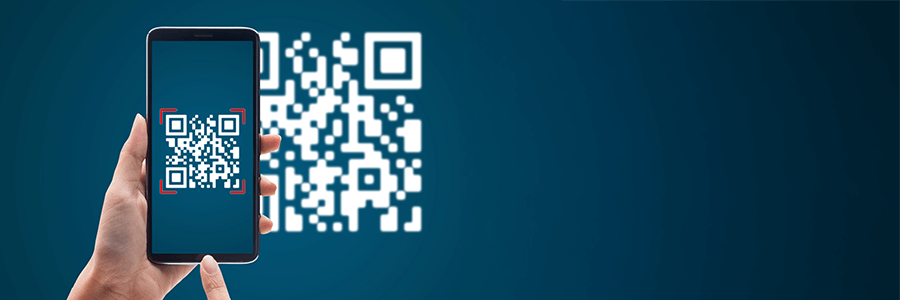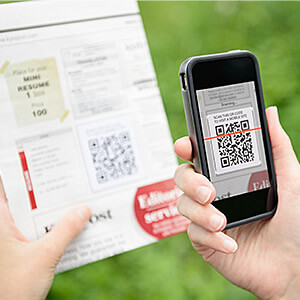Harnessing the Power of QR Codes
in Direct Mail Fundraising
QR codes, or Quick Response codes, have increasingly become a staple in our daily lives, appearing everywhere from restaurants to billboards. Their growing popularity and convenience make them a valuable tool for direct mail fundraising, especially for non-profits looking to engage donors in innovative ways. By incorporating of QR codes into direct mail campaigns, non-profits can streamline donation processes, enhance donor engagement, and elevate their overall fundraising efforts.

Why Use QR Codes in Fundraising Mailings?
QR codes offer a simple, yet powerful, way to bridge the gap between physical mail and digital engagement. With just a quick scan from a smartphone, a potential donor can be directed to a donation page, a video message, or any other online content that supports the organization’s mission. This seamless integration of physical and digital touchpoints allows for a more interactive and engaging donor experience.
According to Statista, QR code usage is projected to grow significantly, with over 100 million users in the U.S. expected by 2025. This rise in usage highlights the potential for non-profits to tap into this growing trend, particularly among younger, tech-savvy donors who are accustomed to digital interactions.
Types of QR Codes and Their Uses
There are two primary types of QR codes: static and dynamic. Static QR codes are fixed and cannot be changed once printed. They are ideal for information that remains constant, such as links to a permanent donation page. On the other hand, dynamic QR codes offer flexibility, allowing non-profits to update the content or correct any errors even after the codes are printed. This adaptability makes dynamic QR codes particularly useful for campaigns that may evolve over time or require frequent updates.
Optimizing QR Codes in Direct Mail Campaigns
To effectively utilize QR codes in direct mail, non-profits should focus on four key strategies:
- Define the Purpose: It’s crucial to clearly define what the QR code will achieve. Whether it’s directing donors to a survey, a registration page, or a donation form, the goal should be clearly aligned with the campaign’s objectives. QR codes can also be used creatively to offer additional content, such as stories from beneficiaries or multimedia that enrich the donor’s connection to the cause.
- Strategic Placement: The placement of a QR code within a mailer is critical to its success. It’s not just about adding a code to the layout, but thoughtfully integrating it in a way that guides the donor’s journey. Testing different placements, sizes, and designs can help determine what works best. Ensuring a clear zone around the QR code for easy scanning and positioning it near call-to-action elements can significantly improve response rates.
- Branding and Creativity: QR codes don’t have to be plain black and white squares. Incorporating brand elements like logos, colors, or even custom shapes can make them stand out and reinforce the organization’s identity. However, these creative touches should always be tested to ensure they do not interfere with the code’s functionality.
- Leverage Data: One of the greatest advantages of QR codes is their ability to track engagement and conversion rates in real-time. This data provides valuable insights into donor behavior and campaign performance, allowing for immediate follow-up actions such as thank-you messages or retargeting unconverted donors. Additionally, by directing donors to online giving, non-profits can capture valuable contact information, enhancing future outreach efforts.
Best Practices for QR Code Use in Fundraising
To maximize the impact of QR codes in direct mail, non-profits should ensure that the landing pages linked via the QR codes are mobile-optimized, with fast load times and clear calls to action. Including short instructions on how to use the QR code can also help reach those who may not be familiar with the technology.
Moreover, it’s essential to maintain multiple response options in the mailer, such as URLs, phone numbers, and traditional mail addresses, ensuring that all donor preferences are accommodated.
Here are some Dos and Don’ts charities can follow when utilizing QR codes for fundraising.
In conclusion,
The integration of QR codes into direct mail campaigns represents a forward-thinking approach that meets donors where they are—on their smartphones. By enhancing the donor experience, providing easy access to digital content, and allowing for real-time tracking, QR codes can significantly boost the effectiveness of fundraising efforts for non-profits. As QR code usage continues to grow, their potential to transform direct mail fundraising will only increase, making them an essential tool for any modern non-profit organization.
Like this article and want to read more like it? Check out, You Can’t Just Set It and Forget It. or Having a Pre-lapsed Strategy Matters.


